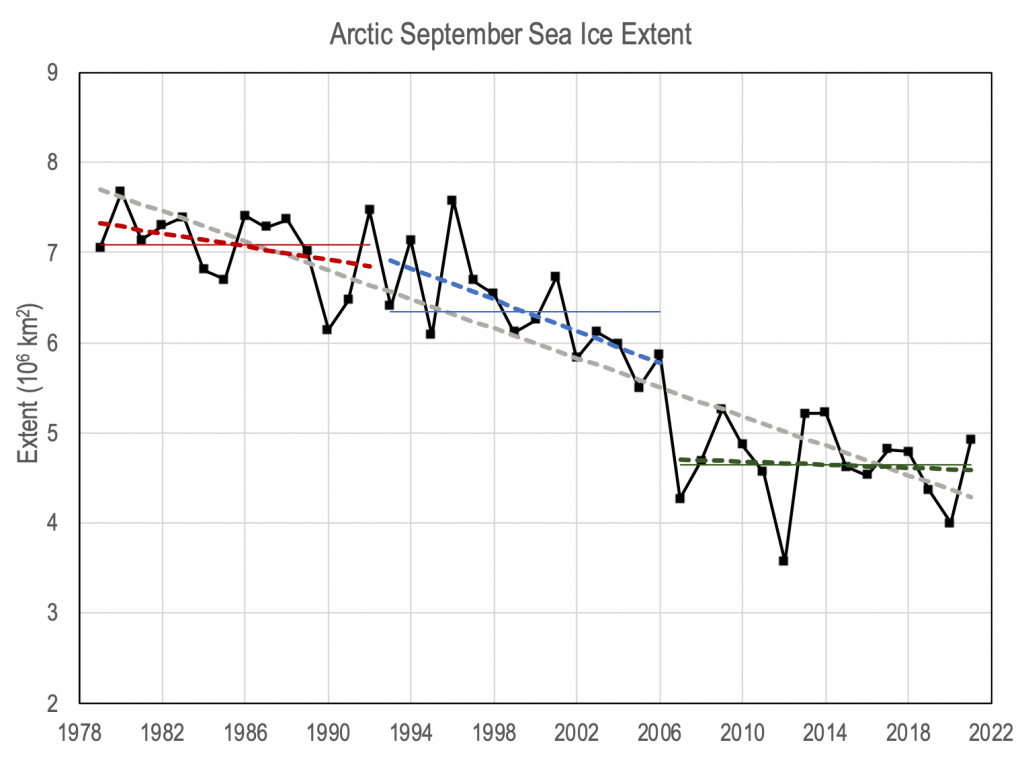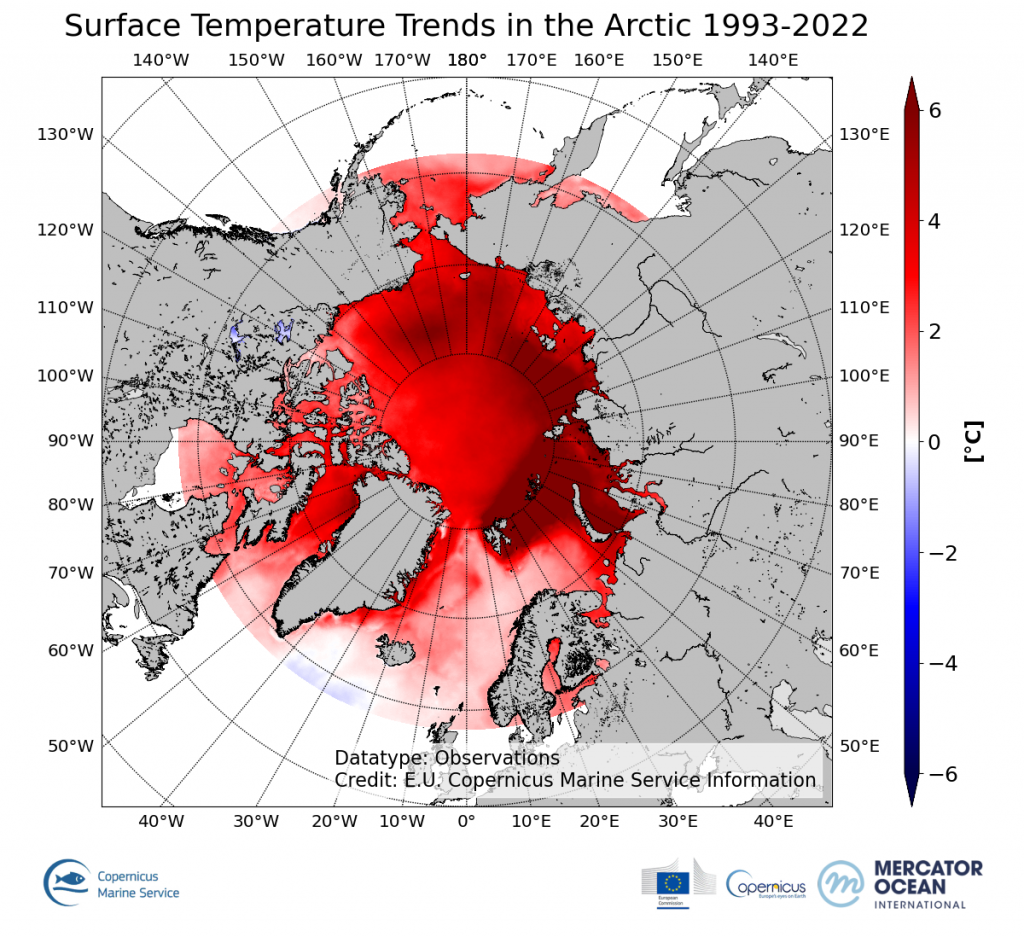

REVIEW
CLAIM: Arctic sea ice is not melting. There is no indication that we should expect the Arctic Sea summer ice to disappear completely, as predicted. CO2 levels don't drive Arctic sea ice decline.
Since the 1970s, satellites have been providing accurate measurements of sea ice extent in the Arctic, revealing a steady reduction in its surface. The yearly extent of Arctic sea ice that survives the entire summer has decreased by approximately 50% from 1979 to 2020 compared to its average extent during the period from 1981 to 2010. Under all Intergovernmental Panel on Climate Change (IPCC) scenarios, even the most optimistic one, the Arctic Sea is expected to reach a mostly ice-free state during some years in the summer as early as the 2040s.
An article by The Epoch Times dated 6 February 2024 disseminated claims challenging the scientific observations of declining arctic sea ice and predictions of an ice-free summer in the Arctic, drawing on assertions from a single report and remarks by an independent consulting engineer.
Arctic sea ice has been shrinking for decades
The title of The Epoch Times article falsely claims that ‘the UN Says Melting Arctic Ice Is Key Indicator of Climate Change—But It’s Not Melting’. This statement is inaccurate, as scientific evidence consistently shows that Arctic sea ice is indeed melting and serves as a critical indicator of climate change.
Arctic sea ice grows and shrinks with the seasons, melting from around March to September and reforming in the cold winter months. Scientists study the yearly minimum extent of Arctic sea ice because it provides critical insights into its seasonal cycle and its response to environmental changes. This measurement, taken at the end of the summer melting season, indicates the quantity of sea ice remaining.
Satellite records have shown that Arctic sea ice extent has steadily declined over the last four decades. In the 1980s, the September average extent represented close to 50% of the March average; from 2013 to 2022, the ratio was only 35%. Reaching lower minimums indicates a weaker recovery in winter, showing that the Arctic is losing ice and failing to replenish it.
In addition, this trend is further reinforced by the fact that sea ice volume is also decreasing. The IPCC notes that:
“Current best estimates from reanalyses indicate that September Arctic sea ice volume has reduced by about 72% over the period from 1979 to 2016, […] a conservative estimate.”[1]
Regarding the trend from the 2010s onwards, the IPCC explains in its report that there is “low confidence in the amount of decrease over this period […] primarily because of snow-induced uncertainties in the retrieval algorithms, the shortness of the record, and the small identified trend.”
Arctic sea ice is forecasted to continue melting
The Epoch Times article quotes a report by Allan Astrup Jensen, a chemical risk assessment specialist, claiming that “in the last 17 years, from 2007 to 2023, the [Arctic sea ice extent] downward trend has also been about zero […] Therefore, there is no indication that we should expect the Arctic Sea summer ice to disappear completely, as predicted, in one or two decades.”
This assertion contradicts the majority of scientific literature on the subject projecting ice free summers later this century, which represents the best evaluation of human knowledge on the topic. Synthesizing this research, the IPCC reports that the current Arctic sea ice extent, both annually and during the late summer, is at its lowest level since at least 1850, with high confidence. In the same fact-sheet the IPCC states that, under all considered scenarios, the Arctic is expected to reach practically ice-free conditions at its summer minimum at least once before 2050.
While Arctic sea ice extent has not declined at a constant rate from 1979 to 2007, the short term fluctuations do not invalidate the overall downward trend (see gray line in Figure 1) and the continued impact of warming expected in the future due to climate change.
The last 17 Arctic sea ice yearly minimum extents are the lowest in the satellite record and summer Arctic sea ice loss since 1979 is unprecedented in 150 years, based on historical reconstructions[2] and more than 1000 years of paleoclimate evidence[3,4,5].
Figure 1 – Arctic Sea ice extent as measured by satellites between 1978 and 2022. The long-term trend for 1979 to 2021 is shown by the dashed gray line, while trends over shorter periods are shown in colors: red for 1979 to 1992, blue for 1993 to 2006, and dark green for 2007 to 2021. (source)
How increasing CO2 concentrations impact Arctic sea ice?
In The Epoch Times’ article, engineer Frank Geisel claims that we do not know whether increased atmospheric CO2 concentrations are driving a decline in sea ice extent and volume. The Epoch Times article’s author picks two CO2 concentration levels and Arctic minimum sea ice extent (in 1979 and 1996) that supposedly supports this claim. However, a physical connection between the two variables cannot be established or dismissed by just cherry-picking two data points, one has to look at all the available evidence and understand the physical mechanism explaining the connection.
As explained below, scientists have established that human-induced climate change causes a decline in Arctic sea ice through various scientific observations and analyses.
Firstly, observational data have shown a clear trend of shrinking sea ice extent and thickness, especially noticeable each September when the ice reaches its annual minimum. Model simulations show this decline correlates closely with rising global temperatures and increased greenhouse gas emissions, consistent with a direct link between increased greenhouse gases concentrations and diminishing sea ice[6]. The IPCC concluded that “it is very likely that anthropogenic forcing mainly due to greenhouse gas increases was the main driver of Arctic sea ice loss since 1979.”[7]
Secondly, studies of the Arctic’s energy balance provide further evidence. Sea ice has a high albedo, meaning it reflects a significant amount of solar energy back into space. As climate change leads to warmer temperatures, sea ice melts, exposing darker ocean water that absorbs more solar energy, leading to further warming and ice loss in a reinforcing feedback loop. This mechanism, well-documented by climate scientists, further demonstrates how increased temperatures from greenhouse gasses directly contribute to the reduction of Arctic sea ice[8].
Lastly, the timing of the melt season has shifted, with ice melting earlier in the spring and freezing later in the fall, further supporting the impact of rising temperatures on sea ice[9]. Records show that increasing global temperatures are happening in tandem with increasing levels of carbon dioxide (see Figure 2, top), while the Arctic has been warming at an even faster rate than the rest of the globe (see Figure 2, bottom), which contributes to Arctic sea ice melting.
Figure 2 – Top: yearly temperature anomalies compared to the twentieth-century average (red and blue bars) from 1880 to 2019, based on data from NOAA NCEI, and atmospheric carbon dioxide concentrations (gray line): 1880-1958 from IAC, 1959-2019 from NOAA ESRL (source).
Bottom: cumulative/net trend in combined sea and ice surface temperature anomalies for the Arctic Ocean from 1993 to 2022. The cumulative trend is the rate of change (°C/year) scaled by the number of years (30 years). Based on satellite observations from the E.U. Copernicus Marine Service Information (source).
Not all the decrease in Arctic sea ice extent is attributed to human induced climate change though. Researchers have found that natural variability accounts for about half of the sea ice decline observed so far; the other half coming from climate change. Therefore, a short period of stable Arctic sea ice extent trend is consistent with the models’ range of predictions. As National Snow and Ice Data Center (NSIDC) scientist Walt Meier pointed out in an article:
“Natural variability has bigger effects at shorter timescales. It mainly plays a role over a time span of about 10 to 15 years. As the length of the observation period increases, natural variability has less effect, and the long-term forcing—greenhouse gas emissions—dominates. There is no escaping that we will see an Arctic with no summer sea ice this century if we continue to rapidly increase greenhouse gases in the atmosphere.”
REFERENCES
- 1 – IPCC (2021) Ocean, Cryosphere and Sea Level Change. In Climate Change 2021: The Physical Science Basis. Contributions of Working Group I to the Sixth Assessment Report of the Intergovernmental Panel on Climate Change.
- 2 – Walsh et al. (2017) A database for depicting Arctic sea ice variations back to 1850. Geographical Review.
- 3 – Polyak et al. (2010) History of sea ice in the Arctic. Quaternary Science Reviews.
- 4 – Kinnard et al. (2011) Reconstructed changes in Arctic sea ice over the past 1,450 years. Nature.
- 5 – Halfar et al. (2013) Arctic sea-ice decline archived by multicentury annual-resolution record from crustose coralline algal proxy. Proceedings of the National Academy of Sciences.
- 6 – Johannessen et al. (2004) Arctic climate change: observed and modelled temperature and sea-ice variability. Dynamic Meteorology and Oceanography.
- 7 – Eyring et al. (2021) Human Influence on the Climate System. In Climate Change 2021: The Physical Science Basis. Contribution of Working Group I to the Sixth Assessment Report of the Intergovernmental Panel on Climate Change.
- 8 – Perovich et al. (2007) Seasonal evolution and interannual variability of the local solar energy absorbed by the Arctic sea ice–ocean system. Geophysical Research Letters.
- 9 – Stroeve et al. (2014) Changes in Arctic melt season and implications for sea ice loss. Geophysical Research Letters.





